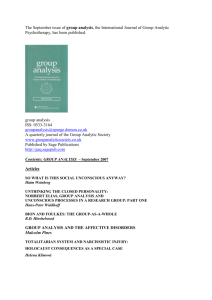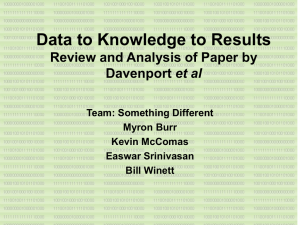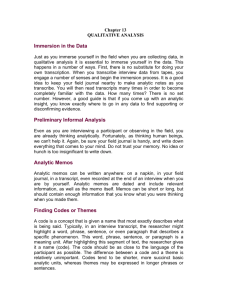Problem set 1
advertisement
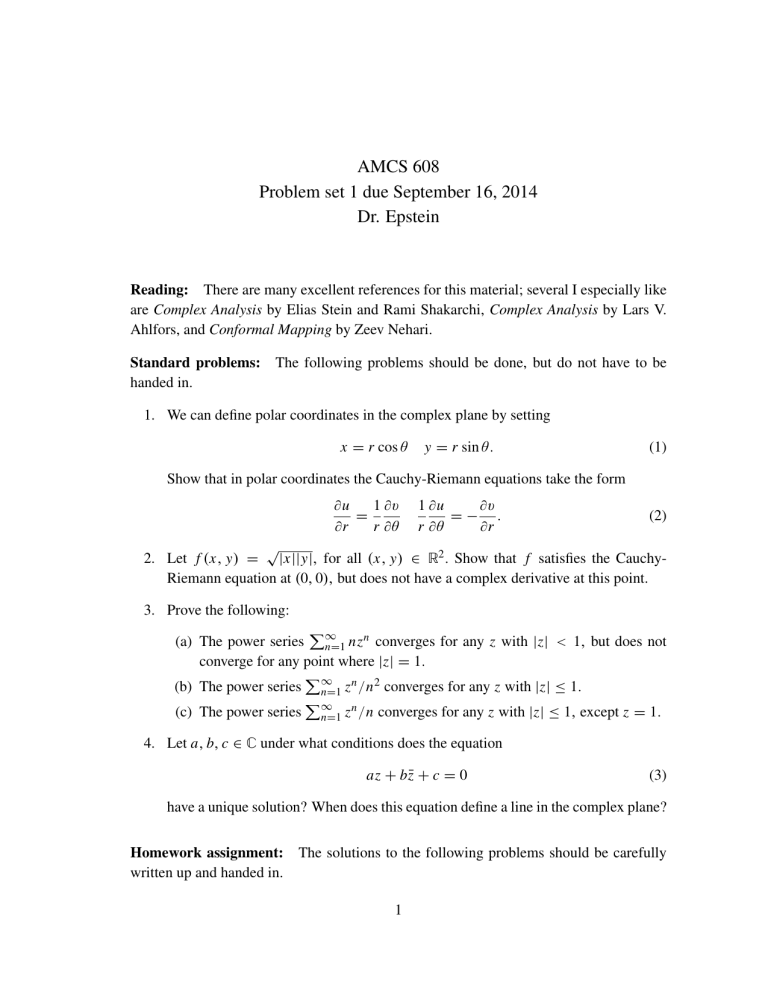
AMCS 608
Problem set 1 due September 16, 2014
Dr. Epstein
Reading: There are many excellent references for this material; several I especially like
are Complex Analysis by Elias Stein and Rami Shakarchi, Complex Analysis by Lars V.
Ahlfors, and Conformal Mapping by Zeev Nehari.
Standard problems:
handed in.
The following problems should be done, but do not have to be
1. We can define polar coordinates in the complex plane by setting
x = r cos θ
y = r sin θ.
(1)
Show that in polar coordinates the Cauchy-Riemann equations take the form
∂u
1 ∂v
=
∂r
r ∂θ
1 ∂u
∂v
=− .
r ∂θ
∂r
(2)
√
2. Let f (x, y) = |x||y|, for all (x, y) ∈ R2 . Show that f satisfies the CauchyRiemann equation at (0, 0), but does not have a complex derivative at this point.
3. Prove the following:
P
n
(a) The power series ∞
n=1 nz converges for any z with |z| < 1, but does not
converge for any point where |z| = 1.
P
n
2
(b) The power series ∞
n=1 z /n converges for any z with |z| ≤ 1.
P
n
(c) The power series ∞
n=1 z /n converges for any z with |z| ≤ 1, except z = 1.
4. Let a, b, c ∈ C under what conditions does the equation
az + bz̄ + c = 0
(3)
have a unique solution? When does this equation define a line in the complex plane?
Homework assignment:
written up and handed in.
The solutions to the following problems should be carefully
1
1. Show that if f is analytic in B R (0) and Re f, or Im f is a constant, then f is constant.
2. Suppose that g is an analytic function defined in U ⊂ C and f is an analytic function
defined in an open set containing g(U ). Show that f ◦g is an analytic function, using
just the definition of complex derivative. Show that the chain rule is valid:
( f ◦ g)0 (w) = f 0 (g(w))g 0 (w).
(4)
3. Verify the chain rule for complex coordinates, e.g. z, z̄, w, w̄ : Suppose that f (z, z̄) :
U → V and g(w, w̄) : V → C, are differentiable in the real sense, i.e. as maps
from subsets of R2 to R2 . As noted in class we can think of f and g as functions of
the variables z, z̄. If we define h = g ◦ f, then show that
∂h
∂g ∂ f
∂g ∂ f¯
=
+
;
∂z
∂w ∂z
∂ w̄ ∂z
(5)
and
∂g ∂ f
∂g ∂ f¯
∂h
=
+
.
(6)
∂ z̄
∂w ∂ z̄
∂ w̄ ∂ z̄
Recall that ∂z = 21 (∂x − i∂ y ) and ∂z̄ = 21 (∂x + i∂ y ). Let f be analytic in a neighborhood of z. Show that the real derivative of f, D f (x, y) : R2 → R2 is invertible at
z = x + i y if and only if f 0 (z) 6= 0.
4. Show that if f is a C1 -function, then
d f = ∂z f dz + ∂z̄ f d z̄.
(7)
Show that any one form α can be written in the form
α = adz + bd z̄,
(8)
dα = (∂z b − ∂z̄ a)dz ∧ d z̄.
(9)
and that
Show that the 1-form α = adz is closed (dα = 0) if and only if a is an analytic
function.
5. Suppose that f, defined in D1 (0), is infinitely differentiable. Show that for each
n ∈ N we have
j
f (z, z̄) =
X
0≤ j+k≤n
∂z ∂z̄k f (0, 0) j k
z z̄ + O(|z|n+1 ).
j!k!
2
(10)
6. If we define log z = log r + iθ, at z = r cos θ + ir sin θ, then show that log z is an
analytic function in the set
{z ∈ C : r 6= 0 and − π < θ < π }.
Sketch this set. Use this to prove that if f is analytic in B R (0) and | f (z)| is constant
then f is constant.
7. Suppose that f is an analytic function defined in U and that c : [0, 1] → U is a
C 1 -curve. The composition t → f (c(t)) can be thought of as a map h from [0, 1]
into R2 . Show that the first derivative of this map can be computed using the chain
rule:
Dh(t) = [Re( f 0 (c(t))c0 (t)), Im( f 0 (c(t))c0 (t))].
(11)
Here we think of c as a complex valued function c(t) = c1 (t) + ic2 (t), with c1 , c2
real valued functions. Note: This does not follow from (4) as c is not an analytic
map (or even defined in an open subset of C).
8. Using the definition of the complex contour integral evaluate the following integrals
over γ , the semi-circle {z : |z| = 1, Im z > 0}, oriented from 1 to −1.
R
(a) dz
z n where n ∈ N.
γ
(b)
(c)
R
γ
R
γ
z̄ n dz, where n ∈ Z.
z n z̄ n dz, where n ∈ Z.
9. Suppose that f (z, z̄) is a C1 , complex valued function defined D1 (0) that satisfies
the partial differential equation
∂z f = 0.
(12)
Let 0 be a C1 , simple closed in D1 (0). What can you say about the value of
I
f (z, z̄)d z̄?
0
Give an example of non-constant function that satisfies (12).
3
(13)

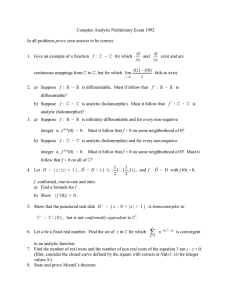
![Mathematics 414 2003–04 Exercises 4 [Due Monday February 2nd, 2004.]](http://s2.studylib.net/store/data/010415765_1-b159664fbd982cf95e1ae146093d034c-300x300.png)
![Mathematics 414 2003–04 Exercises 1 [Due Tuesday October 28th, 2003.]](http://s2.studylib.net/store/data/010415762_1-9e53d350b0430ad1e5431d2ba3c48759-300x300.png)



